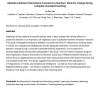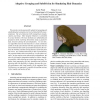53 search results - page 3 / 11 » Continuation methods for adapting simulated skills |
CE
2007
13 years 5 months ago
2007
Adapting training methods to specific teacher traits to best facilitate the training effects for preservice teachers is an important, yet neglected, topic in aptitude-treatment in...
PG
2003
IEEE
13 years 10 months ago
2003
IEEE
We present a novel approach for adaptively grouping and subdividing hair using discrete level-of-detail (LOD) representations. The set of discrete LODs include hair strands, clust...
ROBOCUP
1999
Springer
13 years 9 months ago
1999
Springer
In RoboCup-98, sparrows team worked hard just to get both a simulation and a middle size robot team to work and to successfully participate in a major tournament. For this year, we...
SIGCSE
2008
ACM
13 years 5 months ago
2008
ACM
While the demand for college graduates with computing skills continues to rise, such skills no longer equate to mere programming skills. Modern day computing jobs demand design, c...
EUROGRAPHICS
2010
Eurographics
14 years 1 months ago
2010
Eurographics
When simulating fluids, tetrahedral methods provide flexibility and ease of adaptivity that Cartesian grids find difficult to match. However, this approach has so far been lim...


